Dahren Davey is a London-based artist who specialises in portraiture. Soon after graduating with an MA in Fashion Design from the Royal College of Art, Davey began working in the studio of Vivienne Westwood. He went on to freelance as a designer, fashion illustrator and researcher for magazines and both high street and designer brands. Read on to discover how Davey produces his distinctive portraits.
My way of working is playful and meandering. My pieces are often highly saturated in colour, and I tend to give the subjects large, exaggerated eyes. This occurred naturally, but on reflection I’ve realised it’s probably a result of my attempts to convey more emotion, as people’s eyes speak volumes. I also include other irregular aspects in portraits such as large ears, long necks and different colour usage on different sides of profiles – these are mostly aesthetic choices that have developed over time. These consistencies allow me to explore and change my work, whilst still retaining a set of design aesthetics that are recognisable as my own.

Necesito Ayuda, Mixed Media (ink, marker pen, coloured pencil), 148 x 210mm, 2021
I work on paper. It has the absorbent qualities that allow the media I work with to meld, blend and react in a multitude of ways. I’m obsessed with mark-making – I’m always trying new combinations through layering and juxtaposing marks to produce interesting results in my portraits.
It’s easy to think of regular ways in which a mark can be created. For example, using different tools such as brushes that come in a variety of shapes and sizes; as artists we understand each product will produce a different mark. However, you can also utilize different techniques when using the products – such as holding a brush in a different way, moving a brush in a way that feels unnatural, perhaps, or moving it at a different speed to normal.
When experimenting with how you hold your brush, you could try making marks from drawing with your non-dominant hand. I find that this heightens my awareness of shape and form – it makes me concentrate even more. It also means I can be more relaxed about the outcome. I always have the excuse of saying, ‘Oh, I did that with my opposite hand,’ so it’s understandable that it’s not perfect! The resulting mark or line created in this way will potentially look stilted or have an added texture to it perhaps. Each person trying this exercise will produce a mark that is natural – away from their stylised way of working, which can often be difficult to break out of.
Regarding speed, I can produce marks in a few seconds that cover a lot of space, yet I might spend hours on detailed, realistic aspects. I enjoy this contrast so will often consciously vary the speed at which I work. This inevitably produces an exciting variation of marks.

Mustn't Grumble, Mixed Media (ink, marker pen, coloured pencil), 148 x 210mm, 2022
When I make a ‘mistake’, I see it as an opportunity or even a gift. We all make mistakes, and they are generally perceived as a hindrance in the process or even a reason to start over. Instead, I enjoy ‘correcting’ the mistake. I might work over it or partially cover it, leaving a remnant. The result is often a new, interesting mark that becomes part of the piece in a way that hopefully adds to it in a positive way (you can clearly see this in my piece ‘Mustn’t Grumble’ above). I have repeated this process so often in my work that I now never think of these marks as mistakes – they have become a part of my aesthetic.
I also experiment through combining different media (such as coloured ink, pencil, marker pens and acrylic paint) and through layering (coloured inks over a charcoal drawing, for example). These playful methods, combined with having an open mind to the natural evolution of my work, mean I always enjoy the process of creating new pieces.
Towards the end of my work on a project, I assess my process and ensure that it appears balanced and complete to me. This part of the process is always unique to the artist; what feels complete to one person may look unfinished to another. In order to draw the whole piece together as a whole, colour may need to be added to other parts of the composition or I may need to repeat a mark. I make mental notes of what worked well and what did not, and the more successful aspects will be taken forward into my future work.
Read on for a look at how I experiment throughout my process.

My piece ‘Rain at Last’ is made up of a combination of different media. I begin with a drawing of the face using Graphite Pencil. I continue with an underlay of Promarker for the hair and overlay with ink for detail.

Next, I add detail to the piece with coloured pencils. The finished piece also includes an ink background and the addition of watercolour over the facial features. I then begin my piece ‘Out Last Night’ with Promarker.

I add a layer of various inks, which adds dimension to the piece. More detail is added with coloured pencils. The finished piece also includes various layers of coloured inks to creating shadows. Additionally, I made an interesting mark using a toothbrush.
Although working with a format that’s restricted to the head and shoulders can be limited, fashion itself is constantly evolving – from hair to makeup and accessories – so my subject matter is naturally moving forward. The models themselves also change. The types of people who are used as models within fashion has evolved immensely. Diversity and inclusion are now being addressed by the industry, and this is one of the most interesting parts to respond to.
All images courtesy of the artist, click here to see more of Dahren Davey’s work.

